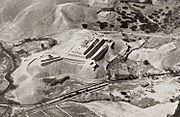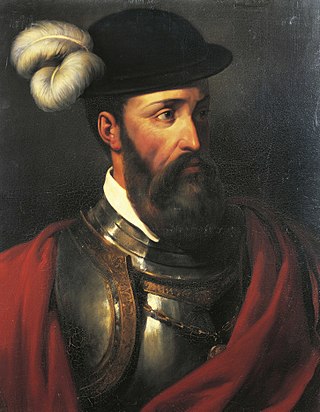
Francisco Pizarro, Marquess of the Atabillos was a Spanish conquistador, best known for his expeditions that led to the Spanish conquest of the Inca Empire.
Pachacámac is an archaeological site 40 kilometres (25 mi) southeast of Lima, Peru in the Valley of the Lurín River. The site was first settled around A.D. 200 and was named after the "Earth Maker" creator god Pacha Kamaq. The site flourished for about 1,300 years until the Spanish invaded. Pachacamac covers about 600 hectares of land.

Atahualpa, also Atawallpa (Quechua), Atabalica, Atahuallpa, Atabalipa, was the last effective Inca Emperor before his capture and execution during the Spanish conquest.

Cajamarca, also known by the Quechua name, Kashamarka, is the capital and largest city of the Cajamarca Region as well as an important cultural and commercial center in the northern Andes. It is located in the northern highlands of Peru at approximately 2,750 m (8,900 ft) above sea level in the valley of the Mashcon river. Cajamarca had an estimated population of about 226,031 inhabitants in 2015, making it the 13th largest city in Peru.

Sacsayhuamán, often spelled Saqsaywaman or Xacxaguaman,, is a citadel on the northern outskirts of the city of Cusco, Peru, the historic capital of the Inca Empire. The site is at an altitude of 3,701 m (12,142 ft).
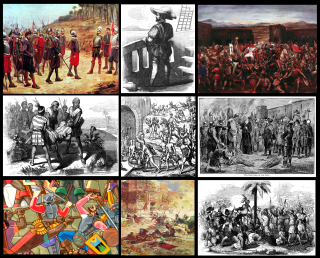
The Spanish conquest of the Inca Empire, also known as the Conquest of Peru, was one of the most important campaigns in the Spanish colonization of the Americas. After years of preliminary exploration and military skirmishes, 168 Spanish soldiers under conquistador Francisco Pizarro, along with his brothers and their indigenous allies, captured the Sapa Inca Atahualpa in the 1532 Battle of Cajamarca. It was the first step in a long campaign that took decades of fighting but ended in Spanish victory in 1572 and colonization of the region as the Viceroyalty of Peru. The conquest of the Inca Empire, led to spin-off campaigns into present-day Chile and Colombia, as well as expeditions to the Amazon Basin and surrounding rainforest.

Manco Inca Yupanqui was the founder and monarch of the independent Neo-Inca State in Vilcabamba, although he was originally a puppet Inca Emperor installed by the Spaniards. He was also known as "Manco II" and "Manco Cápac II". He was one of the sons of Huayna Capac and a younger brother of Huascar.
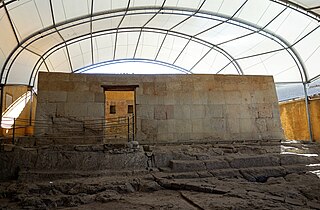
The Ransom Room is a small building located in Cajamarca, Peru. It is considered to be the place where the Inca Empire came to an end with the capture and eventual execution of the Inca Emperor Atahualpa.

Jauja is a city and capital of Jauja Province in Peru. It is situated in the fertile Mantaro Valley, 45 kilometres (28 mi) to the northwest of Huancayo, at an altitude of 3,400 metres (11,200 ft). Its population in 2015 was 15,432.
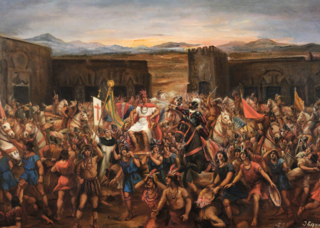
The Battle of Cajamarca also spelled Cajamalca was the ambush and seizure of the Inca ruler Atahualpa by a small Spanish force led by Francisco Pizarro, on November 16, 1532. The Spanish killed thousands of Atahualpa's counselors, commanders, and unarmed attendants in the great plaza of Cajamarca, and caused his armed host outside the town to flee. The capture of Atahualpa marked the opening stage of the conquest of the pre-Columbian civilization of Peru.

Hernando Pizarro y de Vargas was a Spanish conquistador and one of the Pizarro brothers who ruled over Peru.
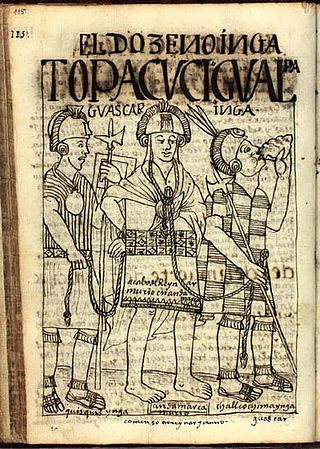
Quizquiz or Quisquis was, along with Chalcuchimac and Rumiñawi, one of Atahualpa's leading generals. In April 1532, along with his companions, Quizquiz led the armies of Atahualpa to victory in the battles of Mullihambato, Chimborazo and Quipaipan, where he, along with Chalkuchimac defeated and captured Huáscar and promptly killed his family, seizing capital Cuzco. Quizquiz later commanded Atahualpa's troops in the battles of Vilcaconga, Cuzco and Maraycalla (1534), ultimately being bested by the Spanish forces in both accounts.
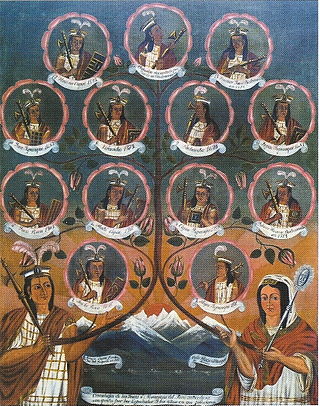
The Incas were most notable for establishing the Inca Empire which was centered in modern day South America in Peru and Chile. It was about 2,500 miles from the northern to southern tip. The Inca Empire lasted from 1438 to 1533. It was the largest Empire in America throughout the Pre-Columbian era. At the peak of the Inca Empire, it was the largest nation in the world and to this day is the largest native state in the western hemisphere. The Inca civilization was located from north to south of the western hemisphere of South America. The Inca state was known as the Kingdom of Cuzco before 1438. Over the course of the Inca Empire, the Inca used conquest and peaceful assimilation to incorporate the territory of modern-day Peru, followed by a large portion of western South America, into their empire, centered on the Andean mountain range. However, shortly after the Inca Civil War, the last Sapa Inca (emperor) of the Inca Empire was captured and killed on the orders of the conquistador Francisco Pizarro, marking the beginning of Spanish rule. The remnants of the empire retreated to the remote jungles of Vilcabamba and established the small Neo-Inca State, which was conquered by the Spanish in 1572.
The Treasure of the Llanganates refers to a huge amount of gold, silver, platinum and electrum artifacts, as well as other treasures, supposedly hidden deep within the Llanganates mountain range of Ecuador by the Inca general Rumiñahui.

Francisco Xerez or Francisco de Jerez (1495–1565?) was a Spanish explorer-turned-historian, the personal secretary of conquistador Francisco Pizarro. He participated in the conquest of Peru during the first two unsuccessful expeditions led by Pizarro, Diego de Almagro and Hernando de Luque in 1524. Xerez did not stay and join The thirteen of the fame in the Isle of Gallo (1526).
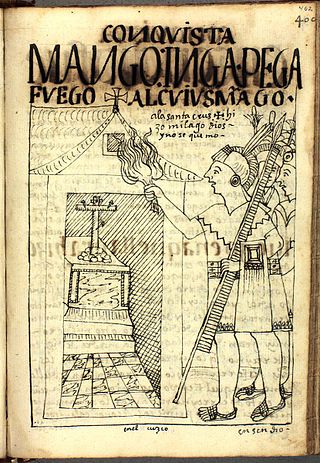
The 10 month siege of Cusco by the Inca army under the command of Sapa Inca Manco Inca Yupanqui started on 6 May 1536 and ended in March 1537. The city was held by a garrison of Spanish conquistadors and Indian auxiliaries led by Hernando Pizarro. The Incas hoped to restore their empire (1438–1533) with this action, but it was ultimately unsuccessful.

The Inca Civil War, also known as the Inca Dynastic War, the Inca War of Succession, or, sometimes, the War of the Two Brothers, was fought between half-brothers Huáscar and Atahualpa, sons of Huayna Capac, over succession to the throne of the Inca Empire. The war followed Huayna Capac's death.
The Battle of Ollantaytambo took place in January 1537, between the forces of Inca emperor Manco Inca and a Spanish expedition led by Hernando Pizarro during the Spanish conquest of Peru. A former ally of the Spaniards, Manco Inca rebelled in May 1536, and besieged a Spanish garrison in the city of Cusco. To end the stand-off, the besieged mounted a raid against the emperor's headquarters in the town of Ollantaytambo. The expedition, commanded by Hernando Pizarro, included 100 Spaniards and some 30,000 Indian auxiliaries against an Inca army more than 30,000 strong.
The Battle of Vilcaconga was a battle during the Spanish conquest of the Inca Empire from November 8–9, 1533. The Spanish won a convincing victory, suffering minimal casualties.

Pedro de Candia was a Greek explorer and cartographer at the service of the Kingdom of Spain, an officer of the Royal Spanish Navy that under the Spanish Crown became a Conquistador, Grandee of Spain, Commander of the Royal Spanish Fleet of the Southern Sea, Colonial Ordinance of Cusco, and then Mayor of Lima between 1534 and 1535. Specialized in the use of firearms and artillery, he was one of the earliers explorers of Panama and the Pacific coastline of Colombia, and finally participated in the conquest of Peru. He was killed in the Battle of Chupas, (Peru), on 16 September 1542, by Diego de Almagro II.




